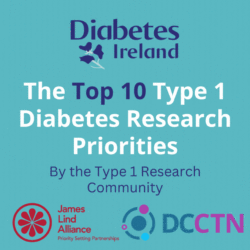A New Study Identifies Key Priorities Driven by Public and Patient Input Sets the Agenda for Type 1 Diabetes Care and Research
A new research paper titled “The Top Ten Priorities in Adults Living with Type 1 Diabetes in Ireland and the United Kingdom – A James Lind Alliance Priority Setting Partnership” has been published, shedding light on the most pressing concerns and priorities of adults living with Type 1 diabetes. This study builds on the work done by the James Lind Alliance and partners in 2011 and the ongoing efforts of Diabetes Ireland, Diabetes UK and Breakthrough T1D to bring person-centred care to the heart of diabetes research and ensuring that the voices of those living with type 1 diabetes are heard and acted upon.
The study, conducted through a collaborative effort by people living with diabetes, their families, diabetes charities and clinical professionals across Ireland and the United Kingdom, utilized the James Lind Alliance (JLA) Priority Setting Partnership (PSP) approach. This method brings together patients, caregivers, and clinicians to identify and prioritize the most critical uncertainties in healthcare that require research attention, the JLA PSP approach ensured that the voices and experiences of those living with Type 1 diabetes were central to determining the most pressing research questions and care priorities.
Key Findings:
The study revealed the top ten priorities for adults living with Type 1 diabetes, reflecting a range of concerns from daily management to long-term outcomes. These priorities are expected to shape the future of diabetes research and healthcare policy in the region.
Dr. Newman the lead author of the study, emphasized the importance of these findings: “This study is a powerful example of how Public and Patient Involvement can shape the future of healthcare. This work highlights the real-world challenges and unmet needs of adults living with Type 1 diabetes. By focusing on these top ten priorities, we can ensure that future research and healthcare services are aligned with what truly matters to those affected by the condition.”
Top Ten Priorities:
- Can the use of artificial intelligence or fasting acting insulins help achieve fully closed loop insulin delivery?
- Is time in range a better predictor of diabetes management and complications compared to HbA1c (an average reading of blood sugar over a 3-month period)?
- What impact do hormonal phases such as the perimenstrual period and menopause play in glycaemic management and what treatments are most effective for managing glucose levels around these times?
- What interventions are the most effective for reducing diabetes related distress and burnout?
- What are the long-term implications of frequent hypoglycaemia on physical and mental health?
- What impact does type 1 diabetes (including frequent low blood sugar) have on memory and cognition in older adults?
- How can health care professionals better take into account the physical, psychological and social aspects of type 1 diabetes in clinics?
- How can access to potential therapies like stem cell therapy, transplants and medications that modify the immune systems be improved so that everyone with type 1 diabetes can be guaranteed access?
- Why do some people with type 1 diabetes become insulin resistant and does resistance increase with the number of years a person has diabetes and if so, why?
- Can technology assist to accurately count carbohydrates without having to weigh or measure all foods and drink?
Implications for Future Research and Policy:
The identified priorities will serve as a roadmap for researchers, funders, and policymakers, guiding future studies and interventions aimed at improving the lives of those living with Type 1 diabetes. This work underscores the critical need for patient involvement in research and highlights the value of the JLA PSP process in addressing complex healthcare challenges.
Significance for Research and Policy:
The study’s PPI-driven approach ensures that the identified priorities are not only reflective of the community’s needs but are also poised to inform and direct future research, funding, and healthcare policy. This collaboration highlights the importance of engaging patients and the public in the research process, ensuring that outcomes are meaningful and relevant.
About Public and Patient Involvement (PPI):
Public and Patient Involvement (PPI) is an approach that places patients and the public at the heart of research and healthcare planning. PPI is research done with or by the public rather than to/for/about them. By placing people with lived experience front and centre, PPI centred research ensures that research priorities and healthcare strategies are aligned with the real needs and concerns of those affected by specific conditions.
About the James Lind Alliance:
The James Lind Alliance is a non-profit initiative that aims to bring patients, caregivers, and clinicians together to identify and prioritize the most important research questions affecting their health. By focusing on patient-centered outcomes, the JLA PSP approach ensures that research efforts are directed toward areas that will have the greatest impact on those living with the condition.
Contact Information:
For more information or to request an interview, please contact:
- Dr Peadar Rooney
- Program Manager Diabetes Collaborative Clinical Trial Network
- programmanger@diabetestrialsctn.ie
- www.diabetestrialsctn.ie
About the Authors:
The study was conducted by a multidisciplinary team of researchers from leading institutions in Ireland and the United Kingdom. The steering committee was composed of people who have Type 1 diabetes, representatives from Diabetes UK, Diabetes Ireland, JDRF and clinicians who work with people who have Type 1 diabetes to manage their symptoms, all of whom are committed to advancing Type 1 diabetes care and research.
Publication Information:
The paper is published in Diabetic Medicine and is available online at https://onlinelibrary.wiley.com/doi/full/10.1111/dme.15429.

